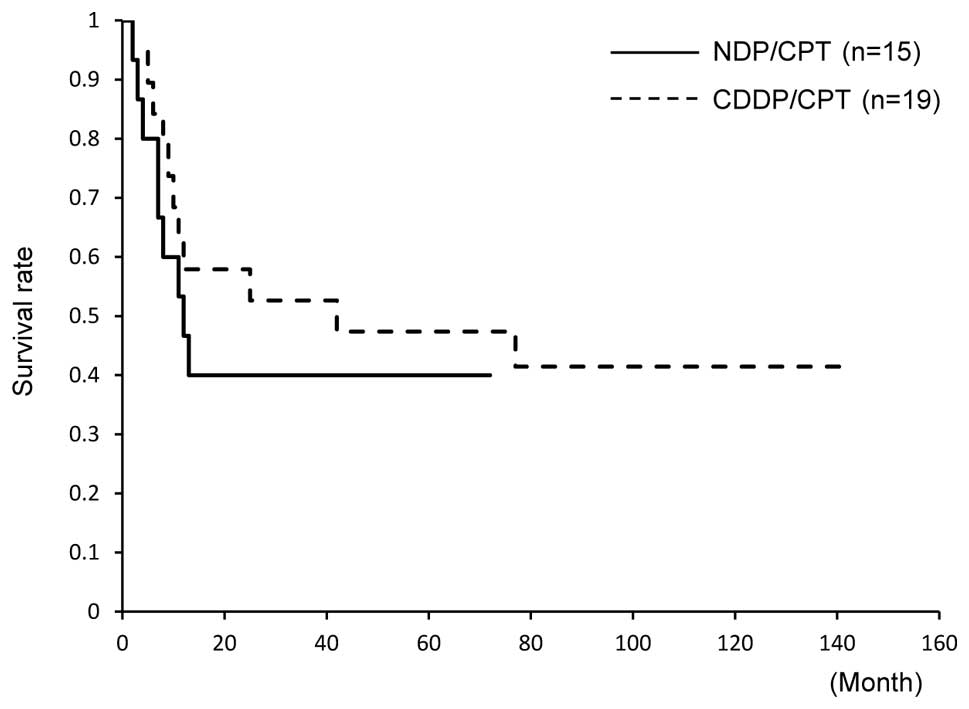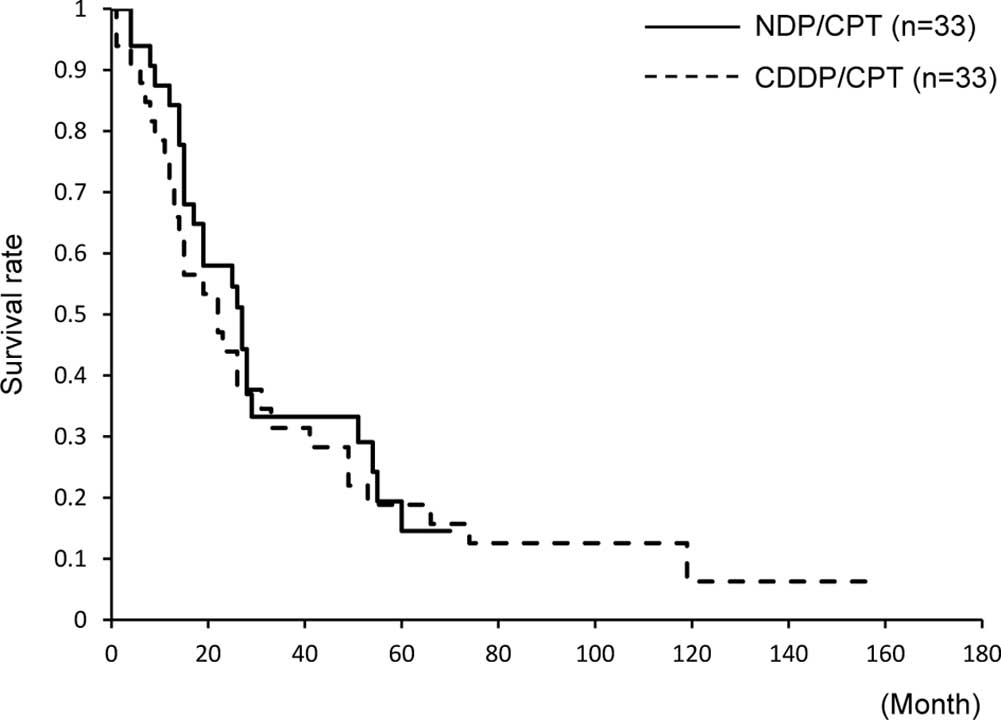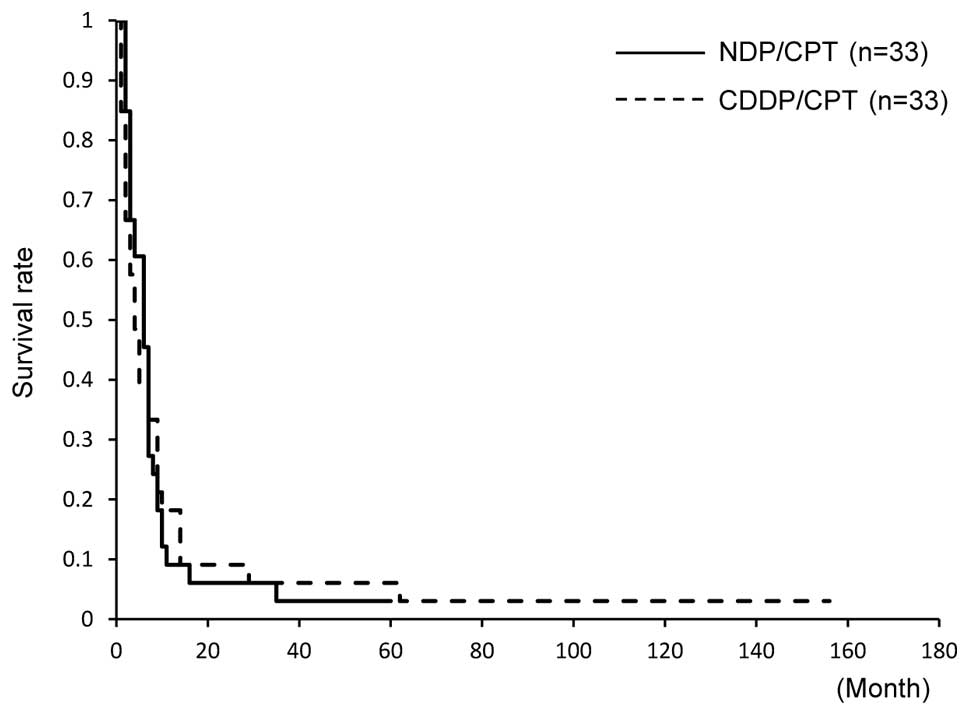Nedaplatin and irinotecan combination therapy is equally effective and less toxic than cisplatin and irinotecan for patients with primary clear cell adenocarcinoma of the ovary and recurrent ovarian carcinoma
- Authors:
- Shizuo Machida
- Tomomi Sato
- Hiroyuki Fujiwara
- Yasushi Saga
- Yuji Takei
- Akiyo Taneichi
- Hiroaki Nonaka
- Mitsuaki Suzuki
-
View Affiliations
Affiliations: Department of Obstetrics and Gynecology, Jichi Medical University, Tochigi 329-0498, Japan
- Published online on: August 6, 2012 https://doi.org/10.3892/ol.2012.853
-
Pages:
1017-1022
Metrics:
Total
Views: 0 (Spandidos Publications: | PMC Statistics:
)
Metrics:
Total PDF Downloads: 0 (Spandidos Publications: | PMC Statistics:
)
This article is mentioned in:
Abstract
This study retrospectively compared nedaplatin and irinotecan hydrochloride (NDP/CPT) combination therapy with cisplatin and irinotecan hydrochloride therapy (CDDP/CPT) for efficacy and adverse events in the treatment of clear cell adenocarcinoma of the ovary (CCC) and recurrent ovarian carcinoma. A total of 115 patients were included in the present study. NDP/CPT was administered intravenously every 4 weeks (NDP, 60 mg/m2 on day 1; CPT, 50 mg/m2 on days 1, 8 and 15). CDDP/CPT was also administered intravenously (CDDP, 60 mg/m2 on day 1; CPT, 60 mg/m2 on days 1, 8 and 15). Patients with primary CCC were treated with NDP/CPT in 29 cases and CDDP/CPT in 20 cases. Patients with recurrent ovarian carcinoma were treated with NDP/CPT and CDDP/CPT in 33 cases each. No significant difference was observed in the 5-year overall survival (OS)/progression-free survival (PFS) of patients with primary CCC, with the exception of those patients with stages Ia and Ic(b) who underwent NDP/CPT and CDDP/CPT treatments (OS: 58%, PFS: 40% and OS: 53% and PFS: 47%, respectively). No significant differences were found in the response rates to NDP/CPT and CDDP/CPT in patients with recurrent ovarian carcinoma (27 and 18%, respectively). Similarly, there were no significant differences in the 5-year OS and PFS of patients with recurrent ovarian carcinoma treated with NDP/CPT or CDDP/CPT (OS: 15%, PFS: 3% and OS: 18%, PFS: 6%, respectively). In terms of the hematological toxicity of grade 3 or above and non-hematological toxicity of grade 2 or above in patients treated with NDP/CPT and CDDP/CPT, respectively, neutropenia was 23 and 56%; anemia, 1, and 20%; thrombocytopenia, 0 and 5%; nausea, 20 and 52%; diarrhea, 14 and 25%; and fever, 2 and 11%. Accordingly, NDP/CPT indicated mild toxicity, and was therefore equally effective and less toxic than CDDP/CPT in the treatment of primary CCC and recurrent ovarian carcinoma.
View References
|
1.
|
SF SerovRE ScullyLH SobinInternational
Histologic Classification of Tumors, No 9 Histological Typing of
Ovarian TumorsWorld Health OrganizationGeneva1973
|
|
2.
|
AP HeintzF OdicinoP MaisonneuveCarcinoma
of the ovary. FIGO 6th Annual Report on Results of Treatment in
Gynecological CancerInt J Gynaecol Obstet95S161S192200617161157
|
|
3.
|
T SugiyamaT KamuraJ KigawaClinical
characteristics of clear cell carcinoma of the ovary: a distinct
histologic type with poor prognosis and resistance to
platinum-based
chemotherapyCancer8825842589200010.1002/1097-0142(20000601)88:11%3C2584::AID-CNCR22%3E3.0.CO;2-510861437
|
|
4.
|
A Du BoisJ HerrstedtAC Hardy-BessardPhase
III trial of carboplatin plus paclitaxel with or without
gemcitabine in first-line treatment of epithelial ovarian cancerJ
Clin Oncol28416241692010
|
|
5.
|
H UtsunomiyaJ AkahiraS
TannoPaclitaxel-platinum combination chemotherapy for advanced or
recurrent ovarian clear cell adenocarcinoma: a multicenter trialInt
J Gynecol
Cancer165256200610.1111/j.1525-1438.2006.00289.x16445610
|
|
6.
|
T EnomotoC KuragakiM YamasakiIs clear cell
carcinoma and mucinous carcinoma of the ovary sensitive to
combination chemotherapy with paclitaxel and carboplatin?Proc Am
Soc Clin Oncol22abs. 17972003
|
|
7.
|
M TakanoY KikuchiN YaegashiAdjuvant
chemotherapy with irinotecan hydrochloride and cisplatin for clear
cell carcinoma of the ovaryOncol Rep1613011306200617089053
|
|
8.
|
M TakanoT SugiyamaN
YaegashiProgression-free survival and overall survival of patients
with clear cell carcinoma of the ovary treated with
paclitaxel-carboplatin or irinotecancisplatin: retrospective
analysisInt J Clin
Oncol12256260200710.1007/s10147-007-0670-117701003
|
|
9.
|
S TakakuraM TakanoF TakahashiRandomized
phase II trial of paclitaxel plus carboplatin therapy versus
irinotecan plus cisplatin therapy as first-line chemotherapy for
clear cell adenocarcinoma of the ovary: a JGOG studyInt J Gynecol
Cancer20240247201010.1111/IGC.0b013e3181cafb4720169667
|
|
10.
|
DM GershensonIrinotecan in epithelial
ovarian cancerOncology (Williston Park)162931200212109803
|
|
11.
|
T SugiyamaM YakushijiT NishidaK UshijimaN
OkuraJ KigawaN TerakawaIrinotecan (CPT-11) combined with cisplatin
in patients with refractory or recurrent ovarian cancerCancer
Lett128211218199810.1016/S0304-3835(98)00065-29683285
|
|
12.
|
S MachidaM OhwadaH FujiwaraPhase I study
of combination chemotherapy using irinotecan hydrochloride and
nedaplatin for advanced or recurrent cervical
cancerOncology65102107200310.1159/00007233312931014
|
|
13.
|
T KatoH NishimuraM YakushijiPhase II study
of 254-S (cis-diammine glycolato platinum) for gynecological
cancerGan To Kagaku Ryoho1969570119921580643
|
|
14.
|
T OtaN TakeshimaK TakizawaSecond-line
chemotherapy for carboplatin/paclitaxel-refractory ovarian cancer:
are multi-agent chemotherapies of little value truly?Eur J Gynaecol
Oncol32471475201122053655
|
|
15.
|
M KoshiyamaM KinezakiT UchidaM
SumitomoChemosensitivity testing of a novel platinum analog,
nedaplatin (254-S), in human gynecological carcinomas: a comparison
with cisplatinAnticancer Res2544994502200516334133
|
|
16.
|
M NishidaH TsunodaY IchikawaH
YoshikawaComplete response to irinotecan hydrochloride and
nedaplatin in a patient with advanced ovarian clear cell
carcinomaInt J Clin
Oncol9403405200410.1007/s10147-004-0413-515549593
|
|
17.
|
Y SasakiT AmanoM MoritaPhase I study and
pharmacological analysis of cis-diammine (glycolato) platinum
(254-S; NSC 375101D) administered by 5-day continuous intravenous
infusionCancer Res511472147719911997185
|
|
18.
|
LS RosenIrinotecan in lymphoma, leukemia,
and breast, pancreatic, ovarian, and small-cell lung
cancersOncology (Williston Park)1210310919989726101
|
|
19.
|
K YamamotoK KokawaN UmesakiPhase I study
of combination chemotherapy with irinotecan hydrochloride and
nedaplatin for cervical squamous cell carcinoma: Japanese
gynecologic oncology group studyOncol
Rep2110051009200910.3892/or_00000316
|
|
20.
|
F OshitaM OheT HondaPhase II study of
nedaplatin and irinotecan with concurrent thoracic radiotherapy in
patients with locally advanced non-small-cell lung cancerBr J
Cancer10313251323201010.1038/sj.bjc.660587520940720
|
|
21.
|
T MikiT NomotoS NakagawaThe salvage
chemotherapy for refractory testicular cancer with novel anticancer
agentsHinyokika Kiyo45811814199910637749
|
|
22.
|
T IshibashiY YanoT OgumaA formula for
predicting optimal dose of nedaplatin based on renal function in
adult cancer patientsCancer Chemother
Pharmacol50230236200210.1007/s00280-002-0488-512203105
|
|
23.
|
S SatoH FujiwaraT OishiEvaluation of a
formula for individual dosage of nedaplatin based on renal
functionCancer Chemother
Pharmacol69599603201210.1007/s00280-011-1739-021918903
|
|
24.
|
H MinamiK SaiM SaekiIrinotecan
pharmacokinetics/pharmacodynamics and UGT1A genetic polymorphisms
in Japanese: roles of UGT1A1*6 and
*28Pharmacogenet
Genomics17497504200710.1097/FPC.0b013e328014341f17558305
|
|
25.
|
G ToffoliE CecchinG CoronaThe role of
UGT1A1*28 polymorphism in the pharmacodynamics and
pharmacokinetics of irinotecan in patients with metastatic
colorectal cancerJ Clin Oncol2430613068200616809730
|














